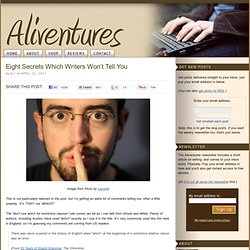

Eight Secrets Which Writers Won’t Tell You. Image from Flickr by Lazurite This is not particularly relevant to the post, but I’m getting an awful lot of comments telling me, often a little snarkily, “it’s ‘THAT’ not ‘WHICH’”.

The “don’t use which for restrictive clauses” rule comes (as far as I can tell) from Strunk and White. Plenty of authors, including Austen, have used “which” exactly as I use it in the title. It’s very commonly used like this here in England, so I’m guessing my comments are coming from US readers. There was never a period in the history of English when “which” at the beginning of a restrictive relative clause was an error. I thought about putting “that” in the title – but I like the sound of “which” between “secrets” and “writers”. And with that out of the way, enjoy the post! A few years ago, I’d look at published writers and think that they were somehow different from me. They were real writers. I’m going to go through eight secrets. Secret #1: Writing is Hard The truth is, though, that writing is hard. 25 Things Every Writer Should Know.
An alternate title for this post might be, “Things I Think About Writing,” which is to say, these are random snidbits (snippets + tidbits) of beliefs I hold about what it takes to be a writer.

I hesitate to say that any of this is exactly Zen (oh how often we as a culture misuse the term “Zen” — like, “Whoa, that tapestry is so cool, it’s really Zen“), but it certainly favors a sharper, shorter style than the blathering wordsplosions I tend to rely on in my day-to-day writing posts. Anyway. Peruse these. Absorb them into your body. Let your colonic flora digest them and feed them through your bloodstream to the little goblin-man that pilots you.
Feel free to disagree with any of these; these are not immutable laws. Buckle up. 1. The Internet is 55% porn, and 45% writers. 2. A lot of writers try to skip over the basics and leap fully-formed out of their own head-wombs. 25 Insights on Becoming a Better Writer. When George Plimpton asked Ernest Hemingway what the best training for an aspiring writer would be in a 1954 interview, Hem replied, “Let’s say that he should go out and hang himself because he finds that writing well is impossibly difficult.

Then he should be cut down without mercy and forced by his own self to write as well as he can for the rest of his life. At least he will have the story of the hanging to commence with.” Today, writing well is more important than ever. Far from being the province of a select few as it was in Hemingway’s day, writing is a daily occupation for all of us — in email, on blogs, and through social media. It is also a primary means for documenting, communicating, and refining our ideas. So what can we do to improve our writing short of hanging ourselves? Fifty (50!) Tools which can help you in Writing. Tension. Hook Your Readers With Tension By Laura Backes, Write4Kids.com Tension.

Without it, life would be—let's face it—boring. So would fiction. Tension works with conflict to raise the emotional level of the text to a boiling point. It forces the reader to become invested in the story. "Tension" is a loaded word, and can be misleading. Tension is what hooks readers of any age and keeps them turning the pages.
. * The ticking clock. . * Dialogue. . * Pacing. . * Sentence structure. Each story requires a different kind of tension. Laura Backes is the author of Best Books for Kids Who (Think They) Hate to Read from Prima/Random House. Copyright © 2002, Children's Book Insider, LLC. Self Publish a Book - Lulu.com. 50 Problem Words and Phrases. Tone/Attitude Words. How I use OneNote for my Dissertation « ProtoScholar. The question came up recently about how I am using OneNote for my dissertation note taking.

Sometimes show is easier than tell. I have one OneNote notebook called Dissertation. Within it, I have 8 sections: A few things about this: The first 5 sections reflect the 5 chapters required in my dissertation: Introduction, Literature Review, Methods, Findings, ConclusionI have a tab called Media into which I put less scholarly discussion around my topic. Within each section, I am creating multiple tabs with notes on specific sub-areas. Notice that the first tab is labeled structure. Below that, each 1st author has a tab. Within each tab, I take notes on the paper. Key things to notice: the bibliographic reference is at the top. In this case I copied the abstract in, since it did a good job of summarizing the paper.
Build bibliographies fast with BibMe - Lifehacker. Kibin Offers Free Editing and Proofreading for Your Papers and Other Writing.